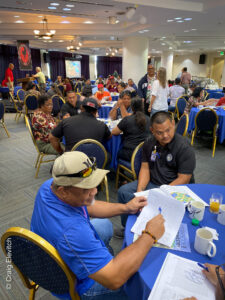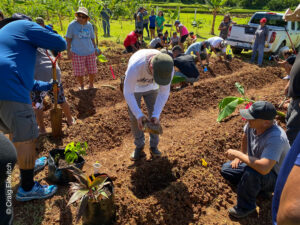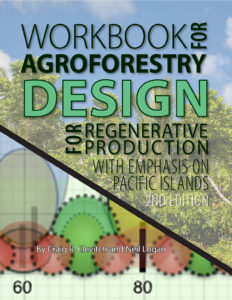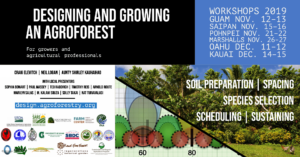Final report for EW16-008
Project Information
This project enhances the ability of agricultural professionals in the Pacific to address food security and natural resource concerns through agroforestry. For millennia, Pacific Islanders relied upon their broad-scale agroforestry systems for sustainable supply of food, fiber, medicine, and materials. These highly productive systems simultaneously provided ecosystem services such as soil and water conservation in the uplands and coastal protection along rivers and coastlines. Many of the legacy agroforestry trees in the U.S.-affiliated Pacific Islands were removed over the past 100 years to accommodate plantation monocultures, open pasture, and urbanization.
Over the past 20 years, there has been increasing awareness of agroforestry as a means of addressing food security, local economic development, and resource conservation needs. A recent survey of participants in the April–June 2015 WSARE-sponsored professional development workshop series “Creative Agroforestry for Food Production in Farm, Home, and Community Landscapes” showed that agroforestry design was the highest priority for further education among agricultural professionals and educators (as well as producers).
Experts in agroforestry design, establishment, and management authored a technical publication for professionals, integrating time-tested traditional Pacific Island agroforestry practices with modern knowledge and technology. All authors have extensive hands-on agricultural field experience in the Pacific. The publication was used as the primary resource for a professional development workshop series.
This project will produce a comprehensive manual for design and management of agroforestry production systems in the U.S.-affiliated Pacific Islands followed by workshops to be presented in Hawai‘i, Guam, and Pohnpei.
Objective 1: Author a comprehensive agroforestry design manual for the U.S.-affiliated Pacific Islands.
Objective 2: Present professional development workshops in Hawai‘i, Guam, and Pohnpei based on the design manual.
Agroforestry systems have been cultivated throughout the Pacific Islands for extremely long periods of time. These biodiverse and productive agroecosystems, rich in woody perennials, exhibit resilience to environmental stressors such as drought and storms as compared with annual crops. Traditional agroforestry systems have been removed over the past 100 years to make way for monoculture export agriculture. There is now growing interest in modern agroforestry systems as a response to climate change and for other benefits such as yield diversification, risk management, and soil and water conservation. Recent responses to climate change are calling for positive adaptation models including agroforestry.
No training materials exist specifically for agroforestry design for Pacific Islands. The training manual generated by this project will be unique in its synthesis of published information on traditional Pacific agroforestry systems combined with modern science and methods. This project builds upon six previous SARE PDP projects by the Project Coordinator that produced publications with over 10 million cumulative downloads since 2000. These projects include Hawai‘i Community-Based Food Security (EW11-014, www.agroforest.info), New Crops for Pacific Island Agroforestry (EW07-004, www.specialtycrops.info), Pacific Island Agroforestry Workshops and Field Visits (EW05-009), Species Profiles for Pacific Island Agroforestry (EW02-001, www.traditionaltree.org), Agroforestry Handbooks for Pacific Islands (EW98-004, www.agroforestry.org/free-publications/agroforestry-guides), and Breadfruit Agroforestry for Pacific Island Revitalization (EW17-004, www.breadfruit.info). A number of other SARE projects (e.g., OW15-031, SW11-055, LS04-162, SW03-055) cover specific agroforestry practices and demonstrations in the Pacific that will be used inform design recommendations, where applicable.
Cooperators
- (Educator)
- (Educator)
- (Educator)
- (Educator)
- (Educator)
Education
This collaborative project brings together expertise in agroforestry, forestry, soil science, agronomy, ethnobotany, plant science, commercial enterprise development, and wildfire management to produce a manual and present workshops about design, implementation, and management of agroforestry systems in the U.S.-affiliated Pacific Islands. The project emphasizes hands-on agroforestry design by including design worksheets in the manual and field plantings during the workshops.


Education & Outreach Initiatives
Produce a comprehensive agroforestry design manual for the U.S.-affiliated Pacific Islands.
The content of the agroforestry design manual was developed through dialog with numerous producers at the outset and during the initial stages of this project. Major topics to be covered include: Introduction to regenerative agroforestry; managing tree-crop competition; goals, skills, and site assessments; determining planting configurations; species selection; implementation, management, and scheduling; and economic analysis. In keeping with the hands-on theme of this project, sample design elements and financial analysis are included to assist ag professionals in design and implementation of economically successful agroforestry projects. All concepts are well illustrated with photographs or line drawings.
A 40-page workshop publication entitled Workbook for Agroforestry Design for Regenerative Production was produced and distributed as a hard copy to the 320 participants of the workshop series. The well received workbook covered six steps in the design process (goals and skills assessment, site assessment, planting configuration, species selection, scheduling, and financial analysis) and allowed workshop participants to run through their own personal design during the workshop. The full design manual is still in production and is expect to be completed by the project coordinator during 2020 with no additional funds needed. Three completed chapters of the manual have been posted for free download at the project web site design.agroforestry.org. All workshop participants and the media will be notified when the manual is completed and all chapters are available.
Outcomes and impacts:
- Bring together traditional and scientific knowledge about designing Pacific Island agroforestry systems in a readily accessible form.
- Stimulate development of educational curricula in agroforestry in universities, colleges, and vocational schools.
- Form a knowledge base that can be used to justify research and demonstration of sustainable agroforestry systems.
- Develop a resource base for design of agricultural systems that meet USDA NRCS resource conservation goals.
- Improved adaptation of local food systems to weather extremes expected due to climate change.
- Rural livelihoods will be improved through crop diversification and development of new local and export markets.

Managing Tree-Crop Competition - Friday
Present three professional development workshops based on the design manual.
The second phase of the project presented workshops in agroforestry design for agricultural extension, NRCS, government agencies, NGO’s, and agricultural professionals. Rather than limiting ourselves to the originally planned three workshops, six workshops were presented in Guam, Saipan, Pohnpei, Marshall Islands, and Hawaii (Oahu and Kauai islands) covering much of U.S.-affiliated Pacific Islands where the need is greatest for revitalization of agroforestry systems.

Workshops consisted of two days of classroom-style presentations focusing on concepts presented in the manual and a day devoted to installation of a small multistory agroforest. Participants learned how to use the workbook and gained experience in agroforestry planning in hands-on design exercises. A team of three trainers from Hawaii led the workshops, while local presenters were included at each workshop in order to emphasize locally appropriate solutions for each island and save on travel costs. Organized by local institutions on each island, over 320 participants in total attended the workshops.
Outcomes and impacts:
- Raise awareness of agroforestry as a viable and sustainable strategy for food production, soil and water resource conservation, and climate change adaptation.
- Increase awareness of viable strategies for agroforestry systems and strategies for implementing them in target audiences.
- Increase understanding of the ecological and economic implications of agroforestry, both advantages and disadvantages.
- Train a new generation of agricultural professionals who will share agroforestry with the general public.
- Extension professionals will increasingly recommend agroforestry systems to clientele as ecologically and economically sustainable alternatives.
- Agricultural micro-enterprises will be strengthened by availability of crops for local and export markets, as well as value-added opportunities.
- University and other research entities will increase their research efforts into diverse and sustainable local food systems.
- Soil and water quality improvement due to conservation services provided by appropriately designed agroforestry systems.
- Decreased use of chemical pollutants in human landscapes.
Educational & Outreach Activities
Participation Summary:
Learning Outcomes
Project Outcomes
The original goal of 200 workshop participants in three workshops was exceeded with over 320 participants in six workshops. When asked, “Did you gain or increase knowledge, awareness and skills about sustainable agricultural topics, practices, strategies, and approaches?”, 96% of participants responded “yes”. To the question, “How many farmers/ranchers do you estimate you will share some asect of this learning event with?”, respondents answered that they expect to impact a total of 2,970 people. The project web site at design.agroforestry.org has received a total of 4,100 hits (by March 2020).
In a post-workshop evaluation that took place several months after the workshops, 84% of participants reported that their ability to include agroforestry practices in their activities had changed significantly (very much: 21%, quite a bit: 39%, some: 24%). 89% reported that the workshop publications significantly impacted their agroforestry planning ability (very much: 32%, quite a bit: 32%, some: 26%).
Representative comments from workshop participants include:
“I learn something, and it makes me reflect myself in the future, I was thinking help others how to grow and also going back to my atoll and do what I learn today. I appreciate this workshop.”—Marshall Islands
“Excellent. Not many people know the info shared.”—Pohnpei
“One of the best classes I’ve attended. I had an idea about agroforestry, but this class clarified and filled in the gaps. Mahalo!”—Oahu
“The design method for determining spacing and the color coding system in the workbook have been helpful with illustrating agroforestry designs for clients as well as understanding the mid-term to long-term succession while still planting everything at the same time.”—Kauai
“I would very much incorporate into my classes being Issues in Pacific Studies and Contemporary Social Issues in Micronesia at the College of the Marshall Islands.”—Marshall Islands
“I will be using the publication in my work field. We have producers who are interested in planting an agroforestry project and the publication does come in handy to help them visualize what an agroforestry would look like.”—Oahu
During 2018, the project leader initiated a related WSARE project “Breadfruit Agroforestry for Pacific Island Revitalization” (EW17-004), which produced a 64-page design guide for agroforestry centered around the production of breadfruit. Producing this breadfruit agroforestry design manual with relatively limited scope as compared to the current project deepened the project team’s ability to present information around agroforestry design in general. Lessons learned during this process have informed some rewrites and new illustration of the design manual and workshops for “Agroforestry Design for Sustainable Production Systems in the U.S.-Affiliated Pacific Islands”. Synergy between the two projects has been highly beneficial for effectively reaching the target audience and is expected to continue to be so throughout the conclusion of both projects.
We were fortunate to have numerous local partners that organized and promoted the workshops. These included University of Guam Western Pacific Tropical Research Center; The Pacific Farmers Together Cooperative; Pacific Islands SBDC Network; Northern Marianas College Cooperative Research, Extension, and Education Services; College of Micronesia-FSM/CTEC; RMI Ministry of Natural Resources & Commerce; College of the Marshall Islands; Sustainable and Organic Agriculture Program at UH CTAHR; Regenerations Botanical Garden; and the Kauaʻi Food Forest. All of these partnerships benefitted synergistically from this WSARE-sponsored project by help build local expertise in regenerative agroforestry.
A range of articles were published about the workshops. One of the best is a comprehensive article published by Civil Beat including participant interviews (https://www.civilbeat.org/2019/12/are-food-forests-the-future-of-agriculture/).